Temple Terminology
Structures of the Buddhist temple
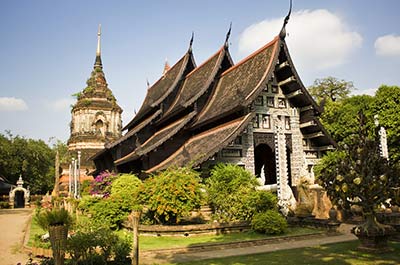
Wat
A Wat is a temple complex, consisting of several buildings like a stupa, a viharn, a bot and other structures, enclosed by a wall. A stupa, viharn and bot are erected first. After that, depending on financial means and the number of monks, other structures like a sala, a scripture hall and living quarters for the monks may be build. On many temple complexes you will also find a school, especially in rural areas.
Shown here is the Wat Lok Molee in Chiang Mai.
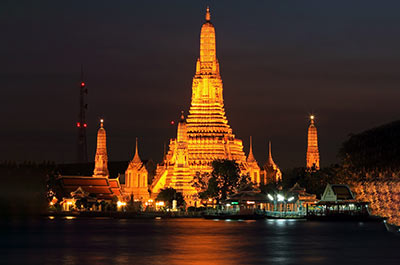
Prang
A prang is a tower with a conical shape with a broad base getting narrower towards the top and an entrance on one side. Prangs originate from Khmer architecture. The oldest prangs in Thailand were inspired by Angkor Wat in Cambodia and can be found in Central and Northeast Thailand in places as Lopburi and Phimai Historical Park. Later on during the Ayutthaya era many prangs were build in a somewhat evolved style.
The best known prang of Thailand is probably the main prang of the Wat Arun, one of Bangkok’s most famous landmarks on the Chao Phraya river.
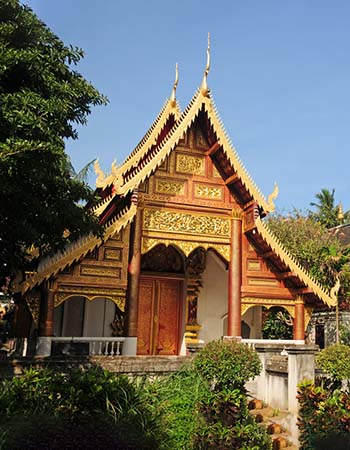
Bot or Ubosot (Ordination hall)
The Bot or Phra Ubosot is the main prayer room and one of the most important structures of the wat. This is the building where monks get ordained. It is also used for other important temple rituals. The bot is a rectangular shaped building with the main entrance facing East. Across from the main entrance sits a glided sitting Buddha image on a richly decorated pedestal. Usually the walls are decorated with murals of the Ramakien, the Thai version of the Indian epic Ramayana or of the Jataka, the stories that tell about the previous lives of the Buddha.
A bot is surrounded by eight boundary stones called sima or sema, that are placed outside the bot in a rectangular shape. A bot and a viharn will usually have similar characteristics, but a viharn does not have the sima stone markers.
Depicted here is the Lanna style ubosot of the Wat Chiang Man in Chiang Mai.
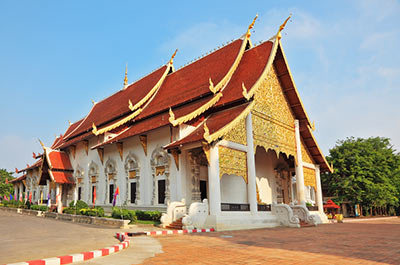
Viharn (Assembly hall)
A viharn or wiharn will often look like the ubosot, except that it is not surrounded by sema stones. In the viharn several Buddhist ceremonies take place with both monks and lay people. Inside the viharn Buddha images are kept. People from outside the Wat come to the viharn to prey. There can be more than one viharn in a Wat. Some viharns are surrounded by a gallery containing a great number of Buddha images. In the early days of Buddhism viharns were build to provide shelter for traveling monks during the rainy season.
Pictured here is the viharn of the Wat Chedi Luang in Chiang Mai.
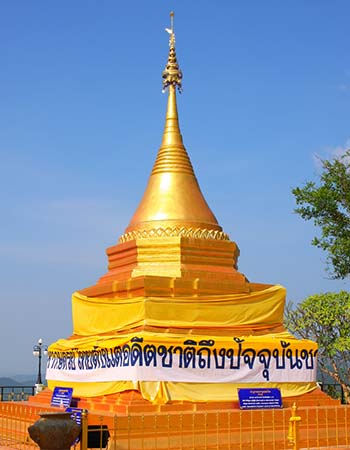
Chedi / Stupa
The chedi, also called stupa or sometimes pagoda is the most important and sacred structure of the wat. Originally, a chedi contained relics of the Buddha, later on they were also used to enshrine the remains of Kings or a very important monk. Chedis are found in various shapes and variations, though typically they have a conical shape. The most used chedi style in Thailand is the bell shaped form. The shape of the chedi is likely derived from an ancient burial mound.
The biggest stupa in the world is the 127 meter high Phra Pathom Chedi in Nakhon Pathom province, close to Bangkok.
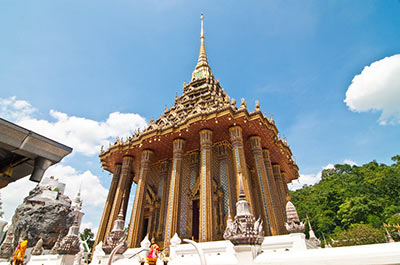
Mondop (Mandapa)
The mondop or mandapa is a usually square and cubical shaped pavilion with a spired roof. It can be used either as a place to store scriptures or objects used in temple ceremonies. Sometimes a mondop houses holy items, like a footprint of the Buddha, like the mondop in Wat Phra Phutthabat in Saraburi.
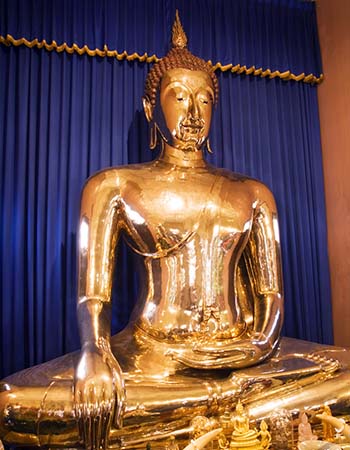
Buddha image
The temple’s principal Buddha image is usually located in the viharn. Both the monks and the local people pray to the image. Often the image will be seated displaying the Calling the Earth to witness mudra.
Pictured here is the gold Buddha of the Wat Traimit in Bangkok, the largest solid gold Buddha image in the world.
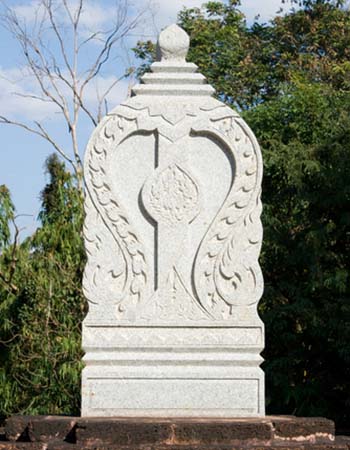
Sema or Sima stones and luuk nimit
Sema or sima stones are used to form a boundary around the bot. A bot always has to be surrounded by eight sema stones, that are placed outside the bot in a rectangular shape. The stones mark the sacred area of the bot. A ninth sema stone is buried under the location of the main Buddha image inside the bot. Beneath the sema stones, buried in the ground are the luuk nimit, which are large iron balls that have to be ritually buried before the boat can be used.
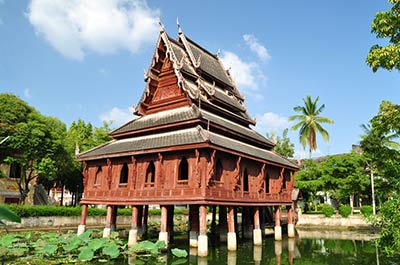
Ho Trai (Scripture library)
The Ho Trai is the library of the Wat where the Buddhist scriptures are kept. Ho Trai structures can be found in many different architectural styles and sizes. Traditionally a Ho Trai was a wooden building on stilts over a pond to keep out all kinds of insects, because in the old days the Buddhist scriptures were written on dried palm leaves.
In Northern Thailand the Ho Trai is often a high brick building with a wooden structure on top of it, like the Ho Trai of the Wat Phra Singh temple in Chiang Mai.
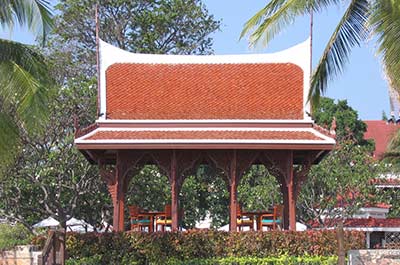
Sala
A Sala is an open rectangular shaped pavilion, used to provide shelter and for resting. Traditionally, a sala was used for purposes as making merit and providing shelter for passing travellers. Salas can be found outside of the Wat as well, often along roads and canals, where they are used as a bus stop or waiting room for passengers of river boats.
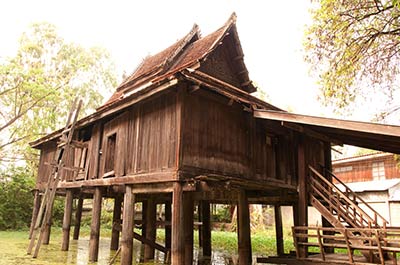
Kuti
The Kuti is the living quarters of the monks living in the Wat. A kuti can appear in many different sizes and shapes. Traditionally a kuti was a very small detached building on stilts. Nowadays, especially in the cities, a kuti is a small room in an apartment building.
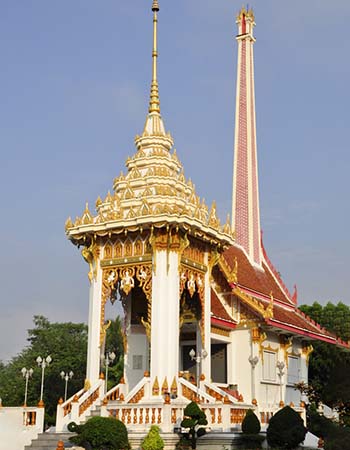
Crematorium
Many Wats in Thailand have a crematorium where the dead are cremated. The crematorium is easily recognizable through the high chimney. Contrary to Western people, most Buddhist people get cremated. After death the relatives will bring the body of the deceased to the temple, where the monks perform Buddhist rites that will benefit the deceased. Usually, a body is cremated within a few days, although sometimes the bodies of rich people can be kept in temple for as long as a year.
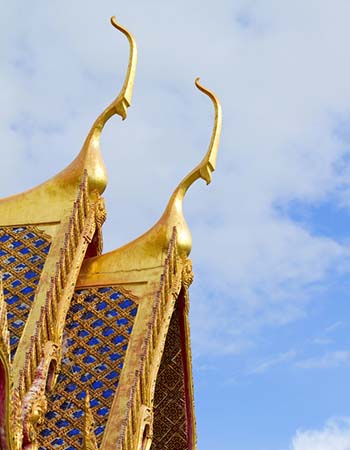
Chofah
Chofah adorn the end of the roof of most temples in Thailand. Shaped like a slender bird, chofah represent Garuda, a large bird like creature from Buddhist and Hindu mythology, the mount of Vishnu.

Dhamma wheel
The Dhamma wheel, also called Dhammachakra or “The wheel of law” symbolizes the Dhamma, the Buddha’s teachings. The wheel is often seen in temples, sometimes accompanied by two deer. After reaching enlightenment, the Buddha held a first sermon at the Deer Park in Sarnath, thus setting in motion the wheel of Dhamma.
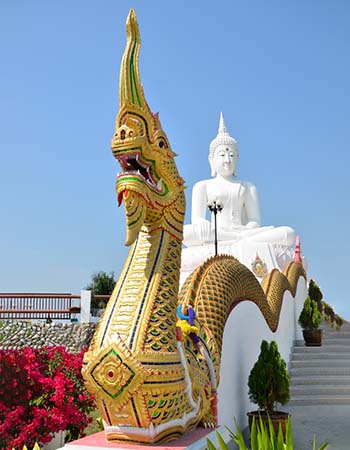
Naga
The Naga is a large mythological snake, often depicted with multiple heads. Naga snakes are often found protecting Buddhist temples, their bodies extending over the balustrades of the stairs that lead to the temple. The most famous Naga is Mucalinda. After having reached enlightenment the Buddha was meditating under a Bodhi tree when a violent storm with torrential rain broke out. Mucalinda appeared and sheltered the Buddha with its hoods from the rain.
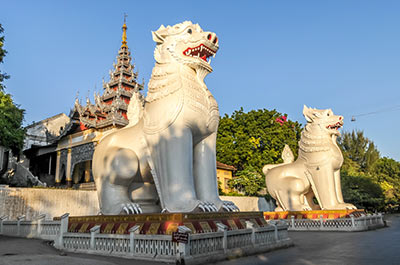
Chinthe
Chinthe, a creature resembling a lion, are often seen at the entrance of temples, mostly in Burma and sometimes in Thailand. They are believed to be guardians of Buddhist temples.
Temples in Thailand
Temple Tours
Temples in Thailand